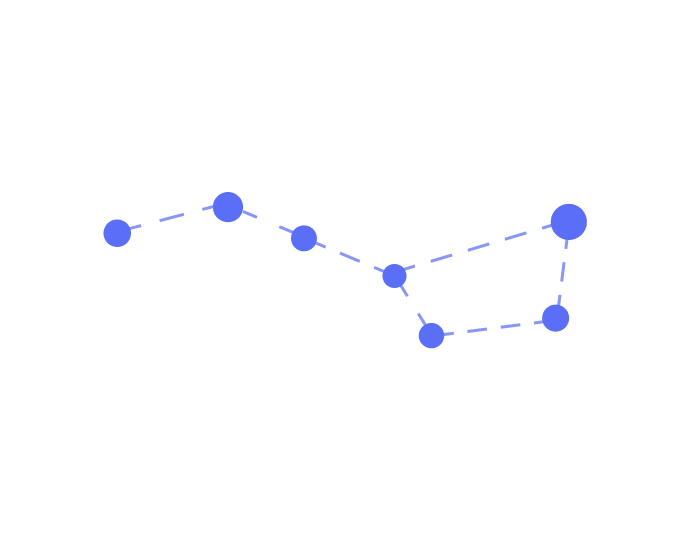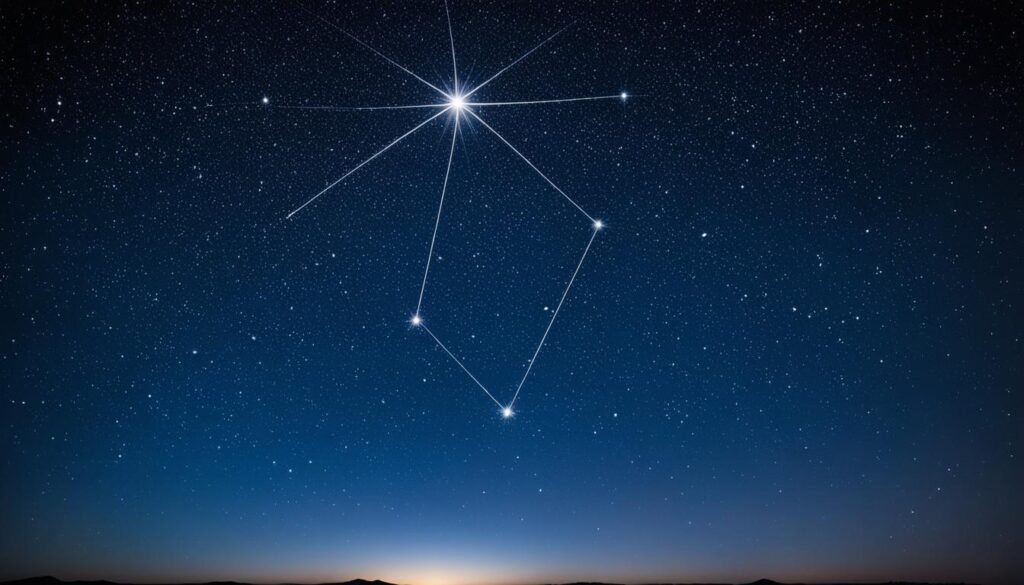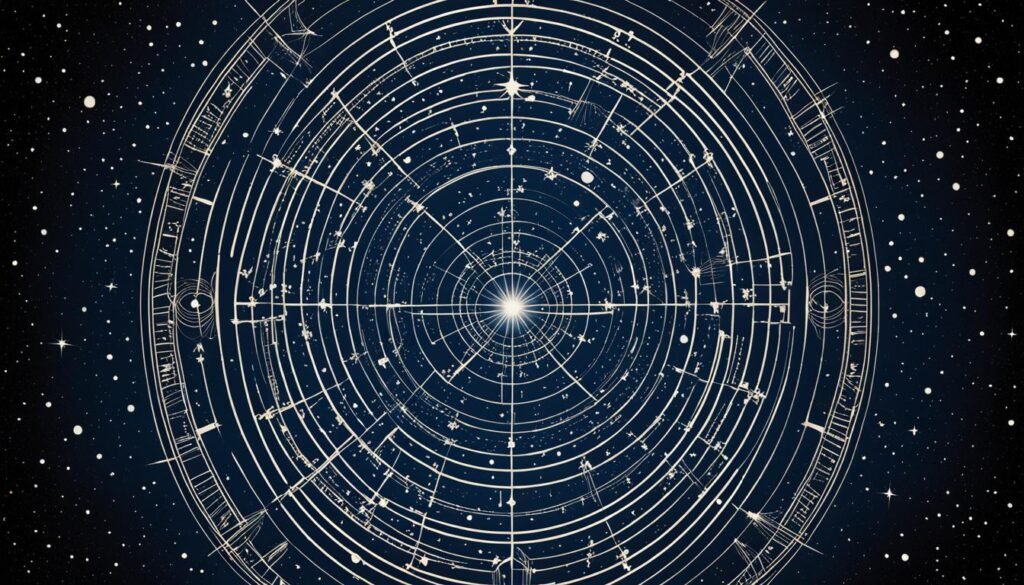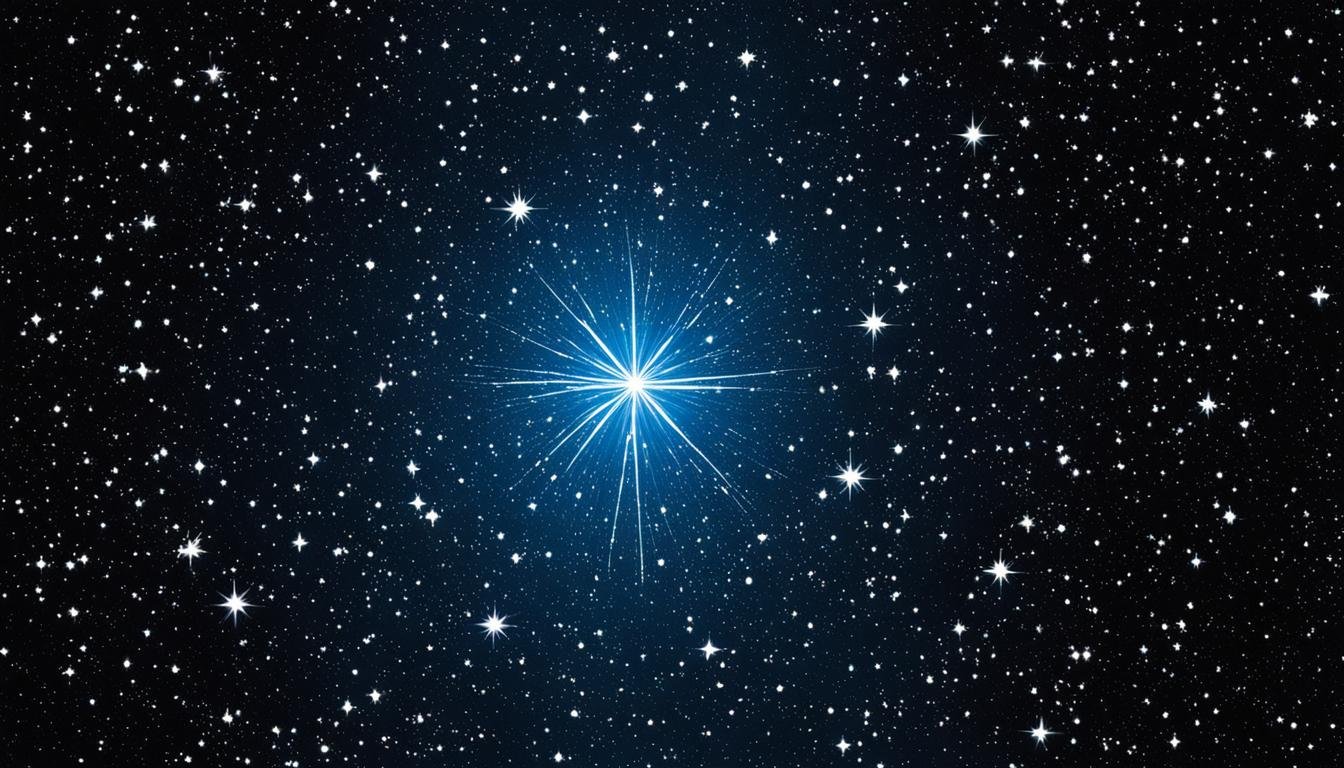
| Genitive | Aurigae |
| Abbreviation | Aur |
| Pronunciation | (ɔːˈraɪɡə) |
| Main Stars | 5, 8 |
| Brightest Star | Capella (α Aur) (0.08m) |
| Right Ascension | 4 hours to 7 hours |
| Declination | 56 deg to -28 deg |
| Sq. Deg. Area | 657 |
| Crosses Meridian | 9PM, late February to early March |
| Visible Lat. Range | +90, -40 deg (°) |
| Best Viewing Season | Winter (Northern Hemisphere) |
When you turn your gaze skyward, the Constellation Auriga offers a storied tapestry that stretches across the celestial sphere. Known as “The Charioteer,” this constellation weaves together a rich history of astronomy and mythology, captivating astronomers and stargazers alike. First cataloged by the ancient astronomer Ptolemy in the 2nd century CE, Auriga has continued to guide and intrigue observers with its distinctive star patterns and deep sky wonders.
Auriga constellation facts reveal a vibrant cosmic section recognized by the International Astronomical Union, adorned with the luminous Capella, its brightest star, which ranks as the sixth-brilliant star in our night sky. Within this celestial dominion, you’ll encounter a trove of open star clusters, the mesmerizing Flaming Star Nebula, and a multitude of stellar spectacles hosting known planets. The constellation also doubles as the radiant for the Alpha Aurigids and Delta Aurigids meteor showers, enhancing Auriga constellation stars’ allure and significance.
Your exploration of the night sky is incomplete without acknowledging the regions represented by these constellations, which not only demarcate the boundaries of our cosmic maps but also echo the ancient stories and myths from a multitude of cultures.
Key Takeaways
- Constellation Auriga is known for its prominent star, Capella, and rich astronomical history.
- The constellation features deep sky objects including star clusters and the Flaming Star Nebula.
- It has found its place in mythologies worldwide, adding cultural depth to its celestial grandeur.
- Functioning as the radiant point for meteor showers adds to Auriga’s observational value.
- With stars harboring planets, it provides a diverse field for astronomical study and discovery.
- Its effect on the night sky is best observed from the northern hemisphere during winter months.
Introduction to Constellation Auriga
Welcome to the fascinating realm of the Constellation Auriga, an emblematic group of stars that promises to inspire stargazers and astronomers alike. Known for its distinctive features and mythological backdrop, the Auriga star constellation provides a celestial tapestry rich in history and splendid in appearance. As you venture through this comprehensive introduction, prepare to be immersed in the astronomical and legendary wonders that make Auriga a standout figure in the cosmic sea.
Legacy of the Charioteer in the Night Sky
The luminous formation of Auriga presents itself as a majestic charioteer, complete with a pointed helmet, portrayed by its major stars. Set against the celestial longitude between latitudes +90° and -40°, its marked outline is perpetuated through the centuries, encapsulating countless tales and astronomical pursuits. During the crisp winter evenings of the northern hemisphere, the constellation becomes an eminent part of the Winter Hexagon asterism, asserting its prominence in the vast sky opposite the galactic center.
Auriga’s Place Among the 88 Modern Constellations
Meandering through the first quadrant of the northern hemisphere (NQ1), the Auriga constellation diagram reveals its adjacency to fellow constellations such as Camelopardalis, Gemini, Lynx, Perseus, and Taurus. As the 21st largest constellation recognized internationally, Auriga boasts an area of 657 square degrees, rendering an unforgettable sight in the night sky. This section of stars contains Capella and is further accentuated by three Messier objects and a number of IAU-recognized stars like Almaaz, Hassaleh, and Menkalinan, anchoring Constellation Auriga information as not only an astral wonder but also a hub of cosmic nomenclature.
| Feature | Description |
|---|---|
| Capella | Brightest star in Auriga, marking the charioteer’s shoulder |
| Messier Objects | Includes M36, M37, and M38 – open star clusters |
| Named Stars | Suns like Almaaz, Hassaleh, and Menkalinan contributing to Auriga’s richness |
| Adjacent Constellations | Close computational proximity to Gemini, Taurus, Perseus, among others |
| Seasonal Visibility | Best viewed during winter evenings in the northern hemisphere |
As a distinguished member of the Perseus constellation family, Auriga continues to maintain its narrative and visual ties with legendary figures and neighboring clusters of stars. With its unique Auriga constellation images and detailed Constellation Auriga information, this sky-high charioteer is a source of curiosity and discovery, beckoning you to look upward and explore the secrets it holds in its stellar embrace.
Exploring the Stars of Auriga
The Auriga constellation, a celestial tapestry woven from ancient myths, also plays host to a fascinate array of stars, each contributing to the distinctive Auriga star patterns recognized by stargazers worldwide. You are invited to dive into the brilliance of the Auriga constellation stars, marvel at their complexity, and understand how they’ve been categorized and charted across time.
Capella, the crowning jewel of this northern constellation, is not just a singular star but a complex quartet comprising two binary pairs. Its constant brightness makes it a reliable beacon in the cosmos. The four stars, forming two larger G-type giants and a pair of smaller red dwarfs, dance in an endless gravitational pull—a ballet visible from our vantage point on Earth.
- Menkalinan—a triple star system whose stellar members are bound by gravity, providing an outstanding example of celestial mechanics at play.
- Mahasim—known for its quick rotation, this peculiar variable star exhibits a strong magnetic field that represents a thrilling curiosity for astrophysicists.
- Hassaleh—a bright giant, its orange hue glows vibrantly against the black curtain of space, and its luminosity far surpasses that of our own sun.
Epsilon Aurigae and Zeta Aurigae contribute to Auriga’s allure with their unique light variations, a result of their binary nature where one star periodically eclipses the other, creating a rhythmic dimming noticeable even to the naked eye. Together with Haedus and Prijipati, these stars complete a cosmic narrative that is both ancient and perpetually unfolding.
The study of these stars not only satiates our curiosity but also provides invaluable insight into the workings of our universe. Their collective patterns form a blueprint for understanding the very fabric of our galaxy—the dynamics of star births, lifespans, and eventual demises.
| Star Name | Star Type | Notable Characteristics |
|---|---|---|
| Capella | Binary Star System | Consists of two G-type giants and two red dwarfs |
| Menkalinan | Triple Star System | Exhibits complex gravitational interactions |
| Mahasim | Variable Star | Features a strong magnetic field due to rapid rotation |
| Hassaleh | Bright Giant Star | Shines with significant luminosity, orange coloration |
| Epsilon Aurigae | Eclipsing Binary | Periodic decrease in brightness due to the eclipse |
| Zeta Aurigae | Binary Star | Known for variability as one star eclipses its companion |
| Haedus | Binary Star | Part of the famed ‘Kids’ of Capella |
| Prijipati | Star | Less known but contributes to the Auriga pattern |

As you step outside and gaze upwards, consider the enduring legacy of the Auriga constellation stars—both as luminous spectacles and as cosmic companions on our perpetual quest for knowledge. Whether you’re an amateur astronomer or simply a lover of the night sky, these stars offer a perpetual source of wonder and scientific discovery.
Deep Sky Wonders Within Constellation Auriga
For those who gaze upon the night sky, Constellation Auriga offers more than just twinkling stars; it is a treasure trove of cosmic phenomena. You can unveil a myriad of Auriga constellation facts by delving into the clusters and clouds that reside within its expanse. Behold the grandeur of its deep sky objects—a testament to the boundless beauty of our universe.
Messier Objects: M36, M37, and M38
The rich tapestry of deep sky objects in Auriga is adorned by the illustrious trio of Messier objects. Known individually as M36, M37, and M38, these open star clusters are akin to jewelry set against the backdrop of night. M36, also known as the Pinwheel Cluster, is relatively young and compact, a stark contrast to the older and denser M37. Completing the trio, M38, or the Starfish Cluster, displays a charming pattern that has mesmerized stargazers for centuries. Each of these clusters provides a unique window into the heart of our galaxy, revealing the intricate dance of stellar formation.
The Splendor of the Flaming Star Nebula (IC 405)
The renowned Flaming Star Nebula, or IC 405, is a spectacle of interstellar artistry within Constellation Auriga. Situated around AE Aurigae, a vagabond star lighting up the interstellar canvas, the nebula’s fusion of light and color evokes a sense of awe with its delicate blend of emission and reflection phenomena. The Flaming Star Nebula is not only a cornerstone in the fascinating repository of Auriga constellation facts but also a favorite among astrophotographers and astronomers who seek out the ephemeral beauty inherently etched in the cosmos.
As you contemplate the vastness of Constellation Auriga, remember that each twinkle is part of a larger celestial symphony. Through the observation of these wondrous deep sky objects, you’re privy to a universal show that has been playing long before mankind and will continue for eons to come. The Auriga star patterns and nebulae await, ready to unveil the mysteries of spacetime to all who cherish the night’s canvas.
Mythology and History: The Tales Behind Constellation Auriga
The night sky whispers ancient stories through the Auriga constellation mythology, a canvas that has captivated humanity since time immemorial. Each star in the Auriga star constellation gleams with narratives of divine beings and their earthly connections.
Erichthonius and the Invention of the Quadriga
In the chapters of Grecian myth, Erichthonius’s brilliance as the inventor of the quadriga endures in the heavens. This ingenious king of Athens, regarded as a child of Hephaestus and fostered by Athena herself, is said to be the mind behind the four-horse chariot. Recognized for his inventiveness, Erichthonius’s celestial embodiment as a charioteer highlights his contributions to culture and civilization.
Myrtilus: A Tragic Hero Among the Stars
The Auriga constellation stars also recount the sorrowful tale of Myrtilus, a character sealed in the vault of the sky by misfortune and treachery. As the ill-fated chariot driver of King Oenomaus, Myrtilus was ensnared in a doomed act of deception. His eventual demise, a curse intertwined with honor, earned him his place among the constellations, marking a story of ambition and consequence.
Capella’s Connection to the Nourishing Goat Amalthea
Marking the shoulder of the celestial charioteer, the star Capella reveals a tender chapter in the Auriga star patterns. Echoes of the mythic goat Amalthea, who fostered the infant Zeus, are found amongst the Auriga constellation stars. Alongside Capella, the ‘Kids’—Epsilon Aurigae, Zeta Aurigae, and Eta Aurigae—serve as a reminder of nourishment and protection, ingrained within the constellation’s lore.

Delving into the Auriga constellation images and diagrams provides you with an atlas of these mythological stories. The figures charted across the cosmos bridge the realm of the divine with the touchpoints of humanity, evoking a sense of awe and belonging through times long past.
| Star Name | Mythological Significance | Visual Magnitude |
|---|---|---|
| Capella | The she-goat ‘Amalthea’ nurturing Zeus | 0.08 |
| Epsilon Aurigae | One of the ‘Kids’ accompanying Amalthea | 2.92 to 3.80 (variable) |
| Zeta Aurigae | One of the ‘Kids’ accompanying Amalthea | 3.75 |
| Eta Aurigae | One of the ‘Kids’ accompanying Amalthea | 3.18 |
As you gaze upon the Auriga star constellation, remember the myths woven into its pattern. Through Auriga constellation diagram, or one of the many Auriga constellation images, you connect with the stories that have shaped human culture, capturing the immortality of their heroes amongst the stars.
Auriga Constellation Across Cultures
The Constellation Auriga is not only a northern celestial spectacle but also a tapestry woven from the threads of many ancient cultures. When you peer into the night sky, you’re not just looking at a collection of stars; you’re glimpsing into a past where these constellations carried profound importance across various civilizations. Here are some Auriga constellation facts that highlight its cultural significance.
Mesopotamia: In the annals of Mesopotamian astronomy, the GAM constellation resonates with the figure of Auriga. Representing a goat-herd, it epitomizes the pastoral imagery deeply rooted in these ancient societies.
Chinese Astronomy: For ancient Chinese astronomers, parts of Auriga were seen as the celestial chariots for their emperors, playing an integral role in festivities linked to the harvest, reflecting its influence on societal and agricultural practices.
Bedouin Starlore: The Bedouin tribes, with their rich legacy of star watching, envisaged the stars of Auriga as a flock of goats, an essential part of their nomadic life and survival. This demonstrates the natural connection between the arrangement of stars and daily life across diverse cultures.
Each interpretation of Constellation Auriga enriches the narrative and expands our understanding of how humans across ages and continents looked up in awe and found ways to incorporate the cosmos into their livelihoods and legends.
In the table below, you can find a comparative view of how different cultures perceived the Constellation Auriga:
| Culture | Symbol | Significance |
|---|---|---|
| Mesopotamian | Goat-Herd (GAM) | Pastoral Life and Protection |
| Chinese | Imperial Chariots | Celebration, Harvest, and Royalty |
| Bedouin | Herd of Goats | Nomadic Existence and Astronomic Navigation |
Understanding the Auriga constellation facts woven into the cultural fabric of different societies allows you to appreciate the timeless allure of the night sky. As you look up at the stars of Auriga, remember that you’re seeing the same patterns that guided shepherds, charioteers, and kings through the ages.
Observing Constellation Auriga: Tips for Amateur Astronomers
As you embark on the stellar journey to explore the Auriga star constellation, your adventure is best embarked upon during the prime viewing window of late February to early March. At around 9 p.m., this constellation unfolds its grandeur for those situated between latitudes +90° and -40°. Auriga, a constellation that is circumpolar in nature for numerous northern observatories, proudly sails across the night sky, offering a view of its resplendent stars like Capella with ease. Gazing eastward from the Greenwich Meridian, Auriga makes a majestic appearance, inviting you to witness a performance in the cosmic theater that is both profound and enduring.
When and Where to Spot Auriga in the Night Sky
Auriga’s tapestry of celestial bodies is visible to your eyes as it transits at a lofty altitude, ideal for those who reside in the northern expanses of our planet. This prominent constellation, punctuated by Auriga constellation stars, comes into clear view as you peer eastward after the twilight hours transition into the darker night canvas. It is an experience that transcends simple observation, enabling you to connect with the narratives etched into the cosmos by ancient civilizations.
Selecting Equipment for Viewing Auriga’s Features
To truly appreciate the intricate details within the Auriga constellation diagram, such as its stellar clusters and ethereal nebulae, the right optical tools are paramount. Equip yourself with a formidable pair of binoculars or a modest telescope to capture the nuance of Auriga constellation images; these tools will reveal the cosmic ballet of binary stars, deliver the radiance of distant suns such as Menkalinan, and display the delicate structures of the Flaming Star Nebula. Thus, your astronomical pursuit becomes an enveloping odyssey, charting the expansive seas navigated by the illustrious Charioteer.
FAQ
What is Constellation Auriga and why is it significant?
Constellation Auriga, known as “The Charioteer,” is a prominent constellation in the northern hemisphere rich in stars and celestial phenomena. It is significant for its blend of history, astronomy, and mythology, and is recognized for its brightest star Capella, forming the pointed-helmet shape in the sky. Auriga is also known for its deep sky objects, such as star clusters and the Flaming Star Nebula, and its role in mythology where it is associated with charioteer legends like Erichthonius and Myrtilus.
Where and when can the Auriga constellation be observed?
The Auriga constellation can be observed from latitudes between +90° and -40°, prominently during the winter evenings in the northern hemisphere. It is best visible during late February to early March around 9 p.m. From many northern locations, Auriga is circumpolar and transits high in the sky, making it easier to observe.
What are the major stars in Auriga?
The major stars of Constellation Auriga include Capella, the sixth-brightest star in the sky, Menkalinan, a triple star system, Mahasim, and Hassaleh. Epsilon Aurigae and Zeta Aurigae are notable for their varying brightness due to their binary nature. Named stars such as Almaaz, Hassaleh, and Menkalinan are significant in the constellation’s narrative.
What deep sky objects are found in Auriga?
Auriga hosts several deep sky objects, including three Messier Objects: M36, M37, and M38. These are open star clusters that offer insights into the structure of our galaxy and star formation. Additionally, the Flaming Star Nebula, or IC 405, is another captivating deep sky object found in Auriga, known for its emission and reflection nebulae.
What are the myths associated with Auriga?
Auriga is tied to various myths, particularly the Greek legend of Erichthonius, an innovative charioteer and king of Athens, and Myrtilus, who was involved in a fateful chariot race with King Oenomaus of Pisa. Capella, Auriga’s brightest star, is associated with Amalthea, the goat that nursed the infant Zeus, and accompanied by stars representing the Kids.
How has Auriga been interpreted in different cultures?
Beyond its Greek origins, Auriga has been recognized in various cultures including Mesopotamia, China, and among Bedouin astronomers. Each culture has its own interpretation, often relating to themes of charioteers, goats, and shepherds, corroborating the universal appeal and recognition of this constellation.
What is the best way to observe the stars and features of Auriga?
Observing Auriga’s stars and features is best done with a good pair of binoculars or a small telescope, allowing for detailed views of its star clusters, nebulae, and binary star dances. A clear winter evening with minimal light pollution will provide the optimal conditions for viewing the constellation’s rich details.
How have Auriga’s stars influenced modern astronomy?
Auriga’s stars have greatly influenced modern astronomy by offering examples of varied celestial phenomena, such as binary star systems, large G-type giants, peculiar variable stars, and strong magnetic fields. Observations of these stars aid in the understanding of stellar evolution, composition, and the dynamics of the cosmos.
What is Auriga’s place among the modern constellations?
Auriga stands as the 21st largest constellation in the night sky among the 88 modern constellations defined by the International Astronomical Union (IAU). It occupies 657 square degrees of the sky and its stars form part of the Perseus family constellation group, sharing mythology and visibility with other related constellations.
Can the constellation Auriga be seen from the southern hemisphere?
Constellation Auriga can be seen from the southern hemisphere, but only from regions above a latitude of -40°. Its visibility may not be as prominent as in the northern hemisphere, and the best observation time might differ based on the observer’s specific geographic location.






